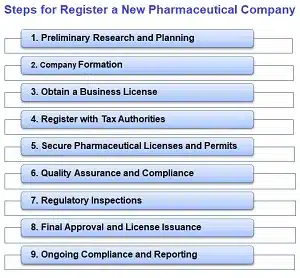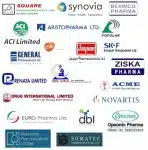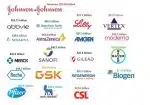To register a new pharmaceutical company and obtain the necessary licenses, you typically need to follow a series of steps that ensure compliance with local, regional, and international regulations.
Table of Contents
The general steps in the registration procedure are listed below:
1. Preliminary Research and Planning
Understand Regulatory Requirements: Research the regulatory requirements specific to the country and region where the company will operate. This includes understanding the rules set by local health authorities, such as the FDA in the United States, EMA in Europe, or MHRA in the UK.
Choose the Type of Business: Decide whether the company will focus on manufacturing, research, distribution, or a combination of these.
Develop a Business Plan: Create a detailed business plan outlining the company’s objectives, market analysis, financial projections, and compliance strategies.

2. Company Formation
Select a Legal Structure: Choose the appropriate legal structure for the company (e.g., Corporation, LTD., Partnership). This will affect liability, taxes, and regulatory requirements.
Register the Company Name: Ensure the chosen company name is unique and complies with local business naming regulations. Register the name with the appropriate government body.
3. Obtain a Business License
Apply for a Business License: Submit an application for a business license to the relevant local or national business registration authority. This typically involves providing details such as the company name, address, ownership structure, and type of business.
4. Register with Tax Authorities
Obtain Tax Identification Numbers: Register the company with local and national tax authorities to obtain the necessary tax identification numbers, such as Tax Identification Number (TIN) for Bangladesh. Employer Identification Number (EIN) for US, Taxpayer Identification Number (TIN) for India.
5. Secure Pharmaceutical Licenses and Permits
Apply for Pharmaceutical Licenses: Apply for the specific licenses required for pharmaceutical operations. This may include:
Manufacturing License: Mandatory for businesses that produce medicine and related products.
Research License: Necessary for companies conducting pharmaceutical research and development.
Distribution License: Needed for companies that will distribute pharmaceutical products.
Submit Documentation: Provide all required documentation, which may include:
Company profile: Including details such as establishment date, type of business, and contact information.
Site Master File: A detailed document describing the manufacturing site’s operations, quality control measures, and compliance with Good Manufacturing Practices (GMP).
Standard Operating Procedures (SOPs): Outlining the processes for manufacturing, quality control, storage, and distribution.
Environmental and Safety Permits: Proof of compliance with local environmental and safety regulations.
6. Quality Assurance and Compliance
Implement Quality Management Systems: Ensure the company has a robust quality management system in place that complies with local and international GMP standards.
Conduct Internal Audits: Perform regular internal audits to ensure compliance with all regulatory requirements and prepare for inspections.
7. Regulatory Inspections
Prepare for Inspections: Regulatory authorities may conduct inspections to ensure the company complies with GMP, GCP (Good Clinical Practice), and GLP (Good Laboratory Practice) standards.
Address Inspection Findings: If any deficiencies are noted during inspections, promptly address them and provide evidence of corrective actions taken.
8. Final Approval and License Issuance
Review by Regulatory Authorities: After all applications and inspections are complete, regulatory authorities will review the documentation and inspection reports.
Receive Licenses and Permits: Upon successful review, the company will receive the necessary licenses and permits to operate legally in the pharmaceutical sector.
9. Ongoing Compliance and Reporting
Maintain Compliance: Continuously comply with all regulatory requirements, including GMP, pharmacovigilance, and periodic reporting to health authorities.
Renew Licenses: Keep track of license expiration dates and ensure timely renewal to avoid disruptions in operations.
10. Post-Market Surveillance
Monitor Product Safety: Establish systems for monitoring the safety and efficacy of pharmaceutical products once they are on the market.
Report Adverse Events: Report any adverse events or product defects to the relevant regulatory authorities promptly.
Summary
Registering a new pharmaceutical company and obtaining the necessary licenses involves a comprehensive process that requires careful planning, adherence to regulatory guidelines, and ongoing compliance. It is advisable to consult with legal and regulatory experts to navigate this complex process effectively.
Frequently Asked Questions (FAQs)
What are the basic requirements to register a new pharmaceutical company?
To register a new pharmaceutical company, you typically need to meet several requirements, including:
Business Plan: A detailed plan outlining your company’s objectives, market strategy, and financial projections.
Legal Structure: Decide on the legal structure (e.g., sole proprietorship, partnership, and corporation) and register the business name.
Licenses and Permits: Obtain necessary licenses and permits from the relevant health and drug regulatory authorities.
Facility Standards: Ensure your manufacturing or distribution facilities meet Good Manufacturing Practice (GMP) standards.
Qualified Personnel: Employ qualified professionals, including pharmacists and quality control staff.
Capital Requirements: Have sufficient capital to meet operational and regulatory expenses.
How long does it take to register a new pharmaceutical company?
The time required to register a pharmaceutical company can vary depending on the country and specific regulatory requirements. The procedure typically takes a few months to more than a year. During this period, there are:
Business Registration: Typically a few weeks.
Obtaining Licenses and Permits: This can take several months, depending on the thoroughness of your documentation and the efficiency of the regulatory body.
Facility Inspection and Approval: If applicable, this step may add additional time depending on compliance with regulatory standards.
Product Registration: If you intend to manufacture or distribute pharmaceutical products, each product may need to be registered, which can also extend the timeline.
What regulatory bodies oversee the registration of a new pharmaceutical company?
The regulatory bodies responsible for overseeing the registration of a pharmaceutical company vary by country. Some of the key agencies include:
United States: The pharmaceutical sector is regulated by the Food and Drug Administration (FDA).
European Union: The European Medicines Agency (EMA) oversees pharmaceutical registration.
Canada: Health Canada is responsible for pharmaceutical regulation.
India: The Central Drugs Standard Control Organization (CDSCO) is the regulatory body.
Bangladesh: Directorate General of Drug Administration (DGDA) is regulated pharmaceutical sector.
Other Countries: Most countries have their own national regulatory authorities, which may work in conjunction with international bodies like the World Health Organization (WHO) for compliance with global standards.
Always check with the relevant local authority for specific requirements in your region.

Abdus Sobhan Salim is professional experienced pharmacist in pharmaceuticals, author and founder of pharmabossbd.com, the first Bangladeshi pharmaceutical blogger since 2019.




Hi, I want to subscribe for this web site to obtain hottest updates, therefore where can i do it please help.